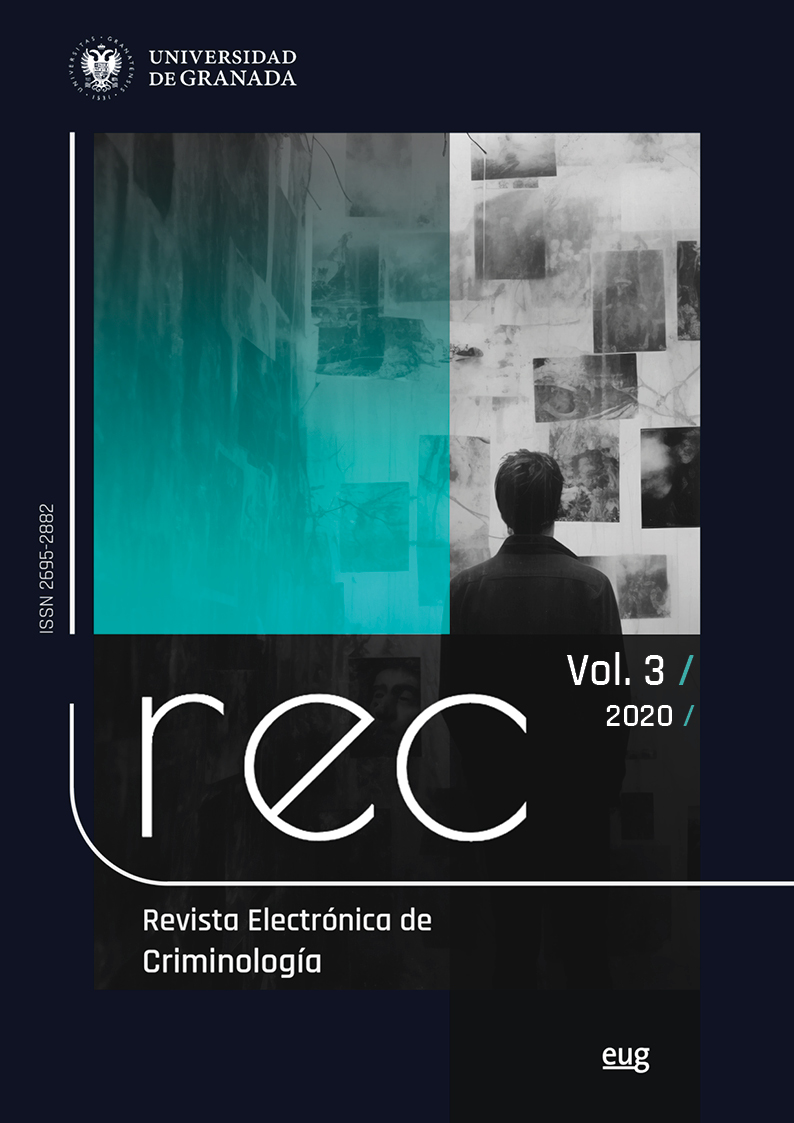Study About Neutralization Techniques In Juvenile Sex Offenders
DOI:
https://doi.org/10.30827/rec.3.33284Keywords:
sexual offenders, juvenile offender, responsability, culpabilityAbstract
Juvenile delinquency is a complex phenomenon that creates great social concern about child sexual abuse and performed by children. To improve comprehension about criminal etiology behind the commission of sexual crimes by minors, a research has been carried out, in which risk factors present in a group of thirteen under-age sex offenders, between 14 and 19 years old whom served sentence for sexual harassment, sexual abuse or rape, between 2013 and 2019, approach of attend to a program aimed to juvenile sex offenders. In conclusion, we observed that most prevalent variables as risk factor proceeded from cognitive distortions, and likewise, that liability attributions are used by the minors as internal and external tools in order to justify and minimize their behaviour and its consequences.
References
Abel, G., Gore, D., Holland, C., Camp, N., Becker, J., & Rathner, J. (1989). The easurement of the cognitive distortions of child molesters. Annals of Sex Research, 2, 135-153. https://doi.org/10.1007/BF00851319
Andújar, M. (2011). Conductas antisociales en la adolescencia (Trabajo de Fin de Máster). Recuperado de: http://repositorio.ual.es/bitstream/handle/10835/1174/Andujar_Martinez_Maria_Belen.pdf?sequence=1
Bandura, A. (1991). Social cognitive theory of moral thought and action. En W. M. Kurtiness y J. L. Gewirtz (Eds.), Handbook of moral behavior and development. 1, (pp. 45-103). New York: Erlbaum & Assoc.
Briet, V., & Suriá, R. (2010). Programa de control de la agresión sexual en adolescentes y jóvenes infractores. Expósito, M. F., Herrera, C., Buela, G., Novo, M., y Fariña, F. (Eds.), Psicología Jurídica: Ámbitos de Aplicación, (pp. 89-96). Santiago de Compostela, España: Consellería de Presidencia, Administracións Públicas e Xustiza. Recuperado de: http://sepjf.org/wpcontent/uploads/2018/12/Vol.10.PsicologaJurdica.mbitosdeAplicacin.pdf
Bumby, K. (1996). Assessing the cognitive distortions in child molesters and rapists: Development and validation of the MOLEST and RAPE scales. Sexual Abuse: A Journal of Research and Treatment, 8, 37-54. https://doi.org/10.1007/BF02258015
Bustamante, C., & Yonatan, A. (2018). Características de los principales modelos comprensivos y explicativos de la agresión sexual y su rol en la intervención con jóvenes ofensores sexuales. Recuperado de: https://www.researchgate.net/publication/322317345_Caracteristicas_de_los_principales_modelos_comprensivos_y_explicativos_de_la_agresion_sexual_y_su_rol_en_la_intervencion_con_jovenes_ofensores_sexuales
Centro de Investigaciones Sociológicas (2019). Barómetro de Mayo: Estudio nº 3247. Recuperado de: http://www.cis.es/cis/export/sites/default/-Archivos/Marginales/3240_3259/3247/es3247mar.pdf
Collings, S. (1997). Development, reliability, and validity of the Child Sexual Abuse Myth Scale. Journal of Interpersonal Violence, 12(5), 665-674. https://doi.org/10.1177/088626097012005004
Consejo General del Poder Judicial (2018). Datos penales, civiles y laborales. Registro Central de Penados y Rebeldes. Recuperado de: http://www.poderjudicial.es/cgpj/es/Temas/Estadistica-Judicial/Estadistica-por-temas/Datos-penales--civiles-ylaborales/Delitos-y-condenas/Condenados--explotacionestadistica-del-Registro-Central-de-Penados-/
Cortoni, F., Gordon, A., Malcolm, B., & Ellerby, L. (1991). The attitudes toward sex with children scale: Preliminary results. Canadian Psychology, 23, 229.
Eccles, A., Stringer, A., & Marshall, W. (1997). Denial and minimization in sexual offenders: A self-report measure. Paper presented at the 16th Annual Research and Treatment Conference of the Association for the Treatment of Sexual Abusers, Arlington, VA.
Echeburúa, E., & Corral, P. de. (2006). Secuelas emocionales en víctimas de abuso sexual en la infancia. Cuadernos de Medicina Forense, (43-44), 75-82. Recuperado en 12 de agosto de 2019, de http://scielo.isciii.es/scielo.php?script=sci_arttext&pid=S1135-76062006000100006&lng=es&tlng=es
Eurostat. (2018). Crime Estatics. Recuperado de https://ec.europa.eu/eurostat/statisticsexplained/index.php?title=Crime_statistics
Federación Española de Asociaciones de Ayuda al Déficit de Atención e Hiperactividad (2019). Datos y cifras. España: FEAADAH. Recuperado de: http://www.feaadah.org/es/sobre-eltdah/datos-y-cifras.htm
Fernandez, Y., Marshall, W., Lightbody, S., & O'sullivan, C. (1999). The child molester empathy measure: Description and examination of its reliability and validity. Sexual Abuse: A Journal of Research and Treatment, 11(1), 17-31.
Ferrer, V., Bosh, E., & Navarro, C. (2010). Los mitos románticos en España. Boletín de Psicología, 99, 7-31. Recuperado de: https://www.uv.es/seoane/boletin/previos/N99-1.pdf
Hart-Kerkhoffs, L., Doreleijers, T., Jansen, L., van Wijk, A., & Bullens, R. (2009). Offense related characteristics and psychosexual development of juvenile sex offenders. Child and Adolescent Psychiatry and Mental Health, 3(19). https://doi.org/10.1186/1753-2000-3-19
Hayashino, D., Wurtele, S., & Klebe, K. (1995). Child molesters: An examination of cognitive factors. Journal of Interpersonal Violence, 10(1), 106-116. https://doi.org/10.1177/088626095010001007
Hunter, J., Figueredo, A., Malamuth, N., & Becker, J. (2003). Juvenile Sex Offenders: Toward the Development of a Typology. Sexual Abuse A Journal of Research and Treatment, 15(1), 27-48. https://doi.org/10.1023/A:1020663723593
Instituto Nacional de Estadística (2018). Población residente por fecha, sexo y edad. Demografía y población. Recuperado de: https://wwwinees.ezproxy.usal.es/dynt3/inebase/es/index.htm?padre=1894&capsel=1895
Johnson, T. (1988). Children who molest other children: Preliminary findings. Child Abuse & Neglect, 12 (2), 219-229. https://doi.org/10.1016/0145-2134(88)90030-0
Ley Orgánica 5/2000, de 12 de enero, reguladora de la responsabilidad penal de los menores. Boletín Oficial del Estado, núm. 11, de 13/01/2000. https://www.boe.es/eli/es/lo/2000/01/12/5/con
López, F. (1998). Agresores y agredidos. Los abusos sexuales de adolescentes. Revista de Estudios de Juventud, 42, 27-33. Recuperado de: http://www.injuve.es/sites/default/files/Revista42-4.pdf
Marshall, W. & Hamilton, K., & Fernandez, Y. (2001). Empathy Deficits and Cognitive Distortions in Child Molesters. Sex Abuse, 13(2), 123–130. http://dx.doi.org/10.1177/107906320101300205
Marshall, W., & Barbaree, H. (1990). An integrated theory of the etiology of sexual offending. En W. Marshall, D. Laws y H. Barbaree (eds), Handbook of Sexual Assault: Issues, Theories, and Treatment of the Offender, (pp. 257-275). New York: Plenum.
Marshall, W., Hamilton, K. & Fernández, Y. (2001). Empathy Deficits and Cognitive Distortions in Child Molesters. Sexual Abuse, 13(2), 123-130. https://doi.org/10.1023/A:1026652321327
Martín, N., & Vozmediano, L. (2014). Conducta de agresión sexual: Revisión de la literatura y propuesta de análisis mediante el modelo de triple riesgo delictivo. International e-journal of criminal sciences, 8. Recuperado de https://www.ehu.eus/ojs/index.php/inecs/article/view/13230
Puyol, C., & Salinas, M. (2013). Agresiones sexuales infanto-juveniles: Una aproximación a víctimas de agresores menores de edad. Salud & Sociedad, 4(3), 266-282. https://doi.org/10.22199/S07187475.2013.0003.00004
Sykes, G., & Matza, D. (2008). Técnicas de Neutralización: una teoría de la delincuencia. Cuaderno CRH, 21(52), 163-170. https://dx.doi.org/10.1590/S0103-49792008000100012
Velden, F., Brugman, D., Boom, J. & Koops, W. (2010). Moral cognitive processes explaining antisocial behavior in young adolescents. International Journal of Behavioral evelopment, 34(4), 292–301. https://doi.org/10.1177/0165
Downloads
Published
How to Cite
Issue
Section
License
Esta obra está bajo una licencia internacional Creative Commons Atribución 4.0.












